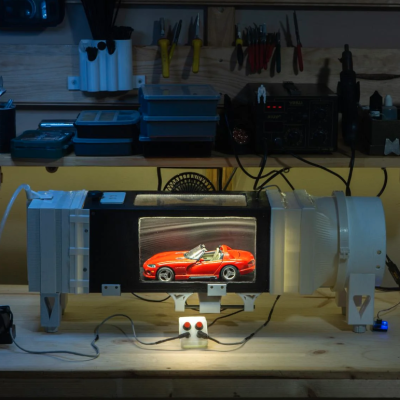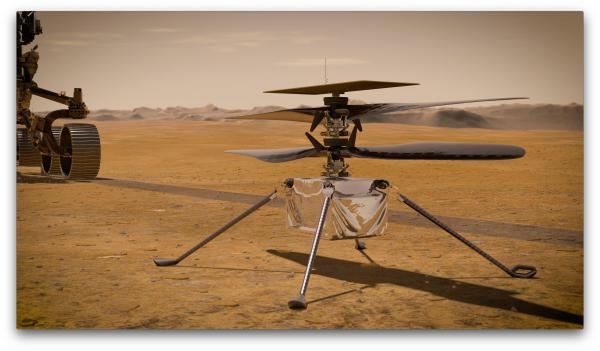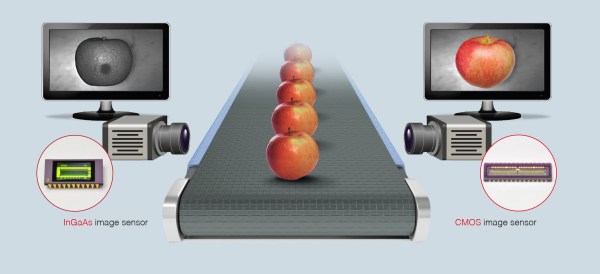Right-to-repair has been a hot-button topic lately, with everyone from consumers to farmers pretty much united behind the idea that owning an item should come with a plausible path to getting it fixed if it breaks, or more specifically, that you shouldn’t be subject to prosecution for trying to repair your widget. Not everyone likes right-to-repair, of course — plenty of big corporations want to keep you from getting up close and personal with their intellectual property. Strangely enough, their ranks are now apparently joined by the Church of Scientology, who through a media outfit in charge of the accumulated works of Church founder L. Ron Hubbard are arguing against exemptions to the Digital Millennium Copyright Act (DMCA) that make self-repair possible for certain classes of devices. They apparently want the exemption amended to not allow self-repair of any “software-powered devices that can only be purchased by someone with particular qualifications or training or that use software ‘governed by a license agreement negotiated and executed’ before purchase.
NASA’s Ingenuity Mars Helicopter Completes 50th Flight
While NASA’s Perseverance rover brought an array of impressive scientific equipment to the surface of Mars, certainly its most famous payload is the stowaway helicopter Ingenuity. Despite being little more than a restricted-budget experiment using essentially only off-the-shelf components that you can find in your smartphone and e-waste drawer, the tenacious drone managed to complete its fiftieth flight on April 13 — just days before the two year anniversary of its first flight, which took place on April 19th of 2021.
Engineers hoped that Ingenuity would be able to show that a solar-powered drone could function in the extremely thin atmosphere of Mars, but the experiment ended up wildly exceeding expectations. No longer a simple technology demonstrator, the helicopter has become an integral part of Perseverance’s operations. Through its exploratory flights Ingenuity can scout ahead, picking the best spots for the much slower rover, with rough terrain only becoming a concern when it’s time to land.
Since leaving the relatively flat Jezero Crater floor on January 19th of 2023, Ingenuity has had to contend with significantly harsher terrain. Thanks to upgraded navigation firmware the drone is better to determine safe landing locations, but each flight remains a white-knuckle event. This is also true for each morning’s wake-up call. Although the rover is powered and heated continuously due to its nuclear power source, Ingenuity goes into standby mode overnight, after which it must re-establish its communication with the rover.
Though there’s no telling what the future may hold for Ingenuity, one thing is certain — its incredible success will shape upcoming missions. NASA is already looking at larger, more capable drones to be sent on future missions, which stand to help us explore the Red Planet planet faster than ever. Not a bad for a flying smartphone.
Continue reading “NASA’s Ingenuity Mars Helicopter Completes 50th Flight”
Hackaday Podcast 209: HDMI Tempest, Norm Upscaled, Seeing Electrons, And When The Radios Go Silent
It was one of those weeks, where Elliot and Dan found a bounty of interesting hacks to choose from for the podcast, making it hard to pick. But pick we did, and we found so many deep and important questions. What good is a leaky HDMI cable? Good for falling down a TEMPEST-like rabbit hole, that’s what. Why would you use a ton of clay to make a car? Because it’s cool, that’s why. What does an electron look like? A little like a wiggling wire, but mostly it looks like a standing wave… of waves.
Is artificial intelligence going to take over all the code and start suing us for copyright violations? Maybe yes, maybe no, but we’re definitely in a strange, new world. And when all our media is on demand, what is the spectrum that broadcasters currently use going to be good for?
It’s not all heavy questions, of course; we found a lot of fun hacks, like an extreme drill press makeover, a couple of low-power cyberdecks, the return of Norm Abram in glorious AI-generated HD, getting up close and personal with flip dot displays, and a sled that lets you go uphill as easily as going downhill.
Check out the links below if you want to follow along, and as always, tell us what you think about this episode in the comments!
Download your own personal copy!
DIY Mini Fridge Is Pure Brilliance In Foam
There’s nothing more pleasing on a hot day than an ice-cold beverage. While the vast majority of us have a fridge in the kitchen, sometimes it’s desirable to have a further fridge in the lab, games room, or workshop. To that end, you may find value in this ultra-cheap, low-cost DIY fridge build from [Handy_Bear].
Like many tiny fridge builds, this design eschews complex gas-cycle refrigeration techniques for simple Peltier modules. These are devices that have one cold side and one hot side, because they move heat when electricity is applied. This build uses a Peltier module fitted with a fan to better shift away heat from the hot side, improving the module’s cooling ability.
The “fridge” itself is assembled out of thick XPS insulation foam. A hot wire cutter was used to cut several slabs which were then assembled using hot glue. The Peltier module is installed on the back, at the top of the fridge. Thus, air which is cooled in this area will then travel down through the rest of the fridge’s cavity. [Handy_Bear] also goes over how to produce a working hinge and a gasket for the door, which helps with ease-of-use and efficiency. As a nice touch, a set of 12V LED lights are also installed inside, which light when the door is open. Just like the real thing!
The final build is noisy, slow to cool down, and it uses 60 watts of power to cool down just two regulation-sized sodas. Notably, you could fit two standard NATO smoke grenades in the same space, as they’re almost-identically sized (ask us how we know). However, smoke grenades don’t usually need to be refrigerated.
None of that means it isn’t fun though! Plus, [Handy_Bear] notes that adding a second Peltier would greatly aid the fridge’s ability to quickly chill your grenades sodas. You might even like to explore the use of special fan designs to make the fridge even quieter! Video after the break.
Continue reading “DIY Mini Fridge Is Pure Brilliance In Foam”
Vapor Trails And Fan Make For Fantastic Photos In DIY Wind Tunnel
Every wanted a mini wind tunnel to check the aerodynamics of scale model cars, drones, or other small objects? Then check out [dannyesp]’s mostly-3D-printed DIY wind tunnel (video, embedded below). Don’t forget to also browse the additional photos in this Reddit thread.

There’s not much for plans available, since as [dannyesp] admits, this device was very much the product of trial-and-error and junk bin parts. The video and photos are more than enough for any enterprising hacker to work with.
The core of the device is a large fan made from a junked drone motor. This fan is located at the rear of the tunnel. A small anemometer is placed at the front, where some 3D-printed baffles also work to smooth out turbulent incoming air.
The foggy trails of vapor come from a hacked-up vape pen. Vapor gets piped through some tubing to the front of the tunnel. There, the vapor trails are drawn towards the low-pressure area at the rear, traveling over and around the object on the way. [dannyesp] also mentions that the platform holding the object is mounted on a rail, which incorporates some kind of pressure sensor in an attempt to quantify wind drag.
We want to take a moment to appreciate just how clean this “junk parts” project looks — even though it is made from things like broken photo frames. All of this comes down to thoughtful assembly. A hack doesn’t have to look like a hack job, after all. We also love the little control box that, instead of having a separate power indicator, lights up like a little nightlight when it has power.
Hacking vaporizers is a fantastic way to create a small, portable fog machine. These can create fantastic costume effects like this smoking Ghost Rider skull. They are a great way to turn an off-the-shelf consumer item into something that cost quite a bit more just a few years back.
Continue reading “Vapor Trails And Fan Make For Fantastic Photos In DIY Wind Tunnel”
Shining A Different Light On Reality With Short-Wave Infrared Radiation
As great as cameras that operate in the visual light spectrum are, they omit a lot of the information that can be gleaned from other wavelengths. There is also the minor issue that visibility is often impacted, such as when it’s raining, or foggy. When this happens, applications such as self-driving cars which rely on this, have a major issue. Through the use of sensors that are sensitive to other wavelengths, we can however avoid many of these issues.
Short-wave infrared radiation (SWIR) is roughly the part of the electromagnetic spectrum between 1.4 μm – 3 μm, or 100 THz – 214 THz. This places it between visible light and microwaves, and above long-wave IR at 20 THz – 37 THz. LWIR is what thermal cameras use, with LWIR also emitted by warm objects, such as the human body.
SWIR is largely unaffected by water in the atmosphere, while also passing through materials that are opaque to visible light. This allowing SWIR to be used for the analysis and inspection of everything from PCBs and fruit to works of art to capture details that are otherwise invisible or very hard to see.
Unfortunately, much like thermal camera sensors, SWIR sensors are rather expensive. Or they were, until quite recently, with the emergence of quantum-dot-based sensors that significantly decrease the costs of these sensors.
Continue reading “Shining A Different Light On Reality With Short-Wave Infrared Radiation”
Hackaday Links: December 12, 2021
It looks as though the Mars Ingenuity flight team is starting to press the edge of the envelope a bit. The tiny rotorcraft, already 280-something sols into a mission that was only supposed to last for about 30 sols, is taking riskier flights than ever before, and things got particularly spicy during flight number 17 this past week. The flight was a simple up-over-and-down repositioning of the aircraft, but during the last few meters of descent at its landing zone, Ingenuity dipped behind a small hill and lost line-of-sight contact with Perseverance. Without the 900-MHz telemetry link to the rover, operators were initially unable to find out whether the chopper had stuck the landing, as it had on its previous 16 flights. Thankfully, Perseverance picked up a blip of data packets about 15 minutes after landing that indicated the helicopter’s battery was charging, which wouldn’t be possible if the craft were on its side. But that’s it as far as flight data, at least until they can do something about the LOS problem. Whether that involves another flight to pop up above the hill, or perhaps even repositioning the rover, remains to be decided.
Thinking up strong passwords that are memorable enough to type when they’re needed is never easy, and probably contributes more to the widespread use of “P@$$w0rD123” and the like than just about anything. But we got a tip on a method the musically inclined might find useful — generating passwords using music theory. It uses standard notation for chords to come up with a long, seemingly random set of characters, like “DMaj7|Fsus2|G#9”. It’s pretty brilliant, especially if you’ve got the musical skills to know what that would sound like when played — the rest of us can click here to find out. But since we can’t carry a tune in a bucket, we’ll just stick with the “correct horse battery staple” method.
Looks like you can only light so many roofs on fire before somebody starts to take an interest in what’s going on. At least that seems to be the case with Tesla, which is now under investigation by the US Security and Exchanges Commission for not keeping its shareholders and the public looped in on all those pesky solar array fires it was having back in the day. The investigation stems from a 2019 whistleblower complaint by engineer Steven Henkes, who claims he was fired by Tesla after pointing out that it really would be best not to light their customers’ buildings on fire with poorly installed solar arrays. It’s interesting that the current investigation has nothing to do with the engineering aspects of these fires, but rather the financial implications of disclosure. We discussed some of those problems before, which includes dodgy installation practices and seems to focus on improperly torqued MC4 connectors.
Staying with the Tesla theme, it looks like the Cybertruck is going to initially show up as a four-motor variant. The silly-looking vehicle is also supposed to sport four-wheel steering, which will apparently make it possible to drive diagonally. We’ve been behind the wheel for nearly four decades at this point and can count on no hands the number of times diagonal driving would have helped, and while there might be an edge case we haven’t bumped into yet, we suspect this is more about keeping up with the competition than truly driving innovation. It seems like if they were really serious about actually shipping a product, they’d work on the Cybertruck windshield wiper problem first.
And finally, as I’m sure you’re all aware by now, our longtime boss Mike Szczys is moving on to greener pastures. I have to say the news came as a bit of shock to me, since I’ve worked for Mike for over six years now. In that time, he has put me in the enviable position of having a boss I actually like, which has literally never happened to me before. I just thought I’d take the chance to say how much I appreciate him rolling the dice on me back in 2015 and giving me a chance to actually write for a living. Thanks, Mike, and best of luck with the new gig!

















